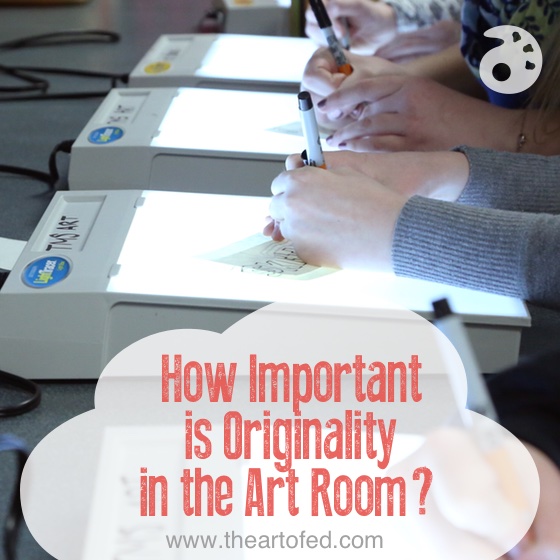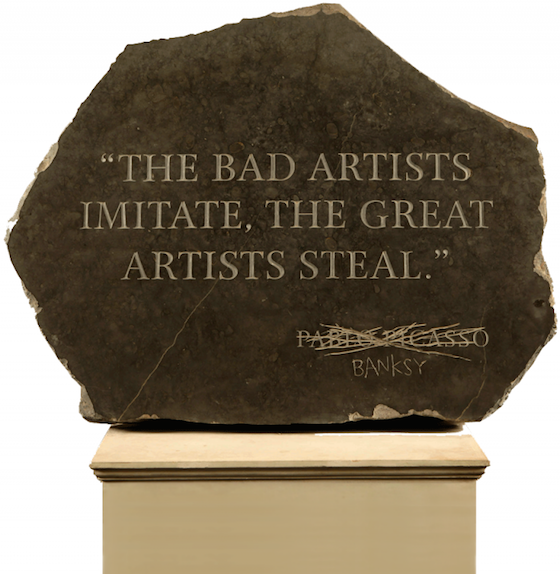
Let’s start with a truth. As teachers, we have so much to juggle: When do I step in and correct this behavior? How and when will I start the new project? Where should this student sit? The list could go on forever. In fact, it’s said that teachers make 1,500 educational decisions every single day. I think it’s fair to say that for everything we do as teachers, there’s probably something we’re neglecting or avoiding, as our time and energy is finite. We’ve got to pick our battles. It’s all a balancing act.
One of the overwhelming, untouched laws of most art rooms is the sacred status of student originality. I think most people use originality and creativity interchangeably, but I think originality has a bit more weight and stigma to it. Originality, by its very definition, implies that nothing else like it exists–it is the first of its origin. Creativity can be a bit more inclusive, with such fuzzy exceptions like appropriation and parody.
If we as teachers demand originality of all of our students at all times, are we in fact neglecting or avoiding other issues? Think specifically about working with difficult or stubborn students and how frustrated they must feel when we adopt an unflinching adherence to originality. Do any other subjects during the day operate this way?
Are students expected to add something to the entire field of science that is completely original?
Of course not. That’s ridiculous.
But we still adhere to this notion that students, and here I’m thinking specifically of middle school kids, have to come up with something completely original in art on a weekly basis.
So let’s look at the pros and cons of pushing originality.
The Pros of Pushing Originality
The pros of teaching originality are pretty obvious. An art program that only focuses on building skills by copying famous works or teacher examples is missing out on a huge piece of what the arts teach students–skills like creativity, critical thinking, and complex communication. These skills happen naturally and frequently when students come up with original ideas. But, I’d argue those same skills can develop, albeit on a smaller scale, even if students aren’t always being 100% original.

The Pitfalls of Pushing Originality
So, what could possibly be wrong with pushing originality? Let’s think about students that have a difficult time starting new projects. They struggle to come up with new ideas. They’ve been told what to do and how to think for so long that when we present them with limitless opportunities, they can get bogged down.
I’ve always been a firm believer that kids would rather be seen as tough than struggling, especially by their peers. So, when students feel stuck on a project, motivation drops and behavioral issues sprout up. The exception here might be some of our gifted and naturally engaged students. However, rarely is a class comprised only of these types of students.
What if instead of holding onto originality, we could find ways for students to ease into creating without feeling like they’ve got to reinvent the wheel? What if we tap into their interests and modify their assignments? I like to think about it in this way: I don’t have a problem with students working around their own limitations in skill. This might include using a photocopier, light box, or projector to get assist with deficiencies in drawing. In the same vein, I don’t have an issue with students borrowing and appropriating from pop culture when it comes to creating artwork, especially if it gets them out of the rut of self-doubt and apathy. In fact, one could argue that when our students use imagery from their visual culture it’s akin to what Pop Art and Post-Modern Artists have been doing for some time.

Students experience joy and learning through making. If we place originality as the gatekeeper of making, then we’re prematurely cutting off a good number of students.
{image source}
So where do you stand on the issue of adhering to student originality?
Have you ever lowered the bar or done away with originality to jumpstart your students’ learning? Was it a successful gambit?
Magazine articles and podcasts are opinions of professional education contributors and do not necessarily represent the position of the Art of Education University (AOEU) or its academic offerings. Contributors use terms in the way they are most often talked about in the scope of their educational experiences.




